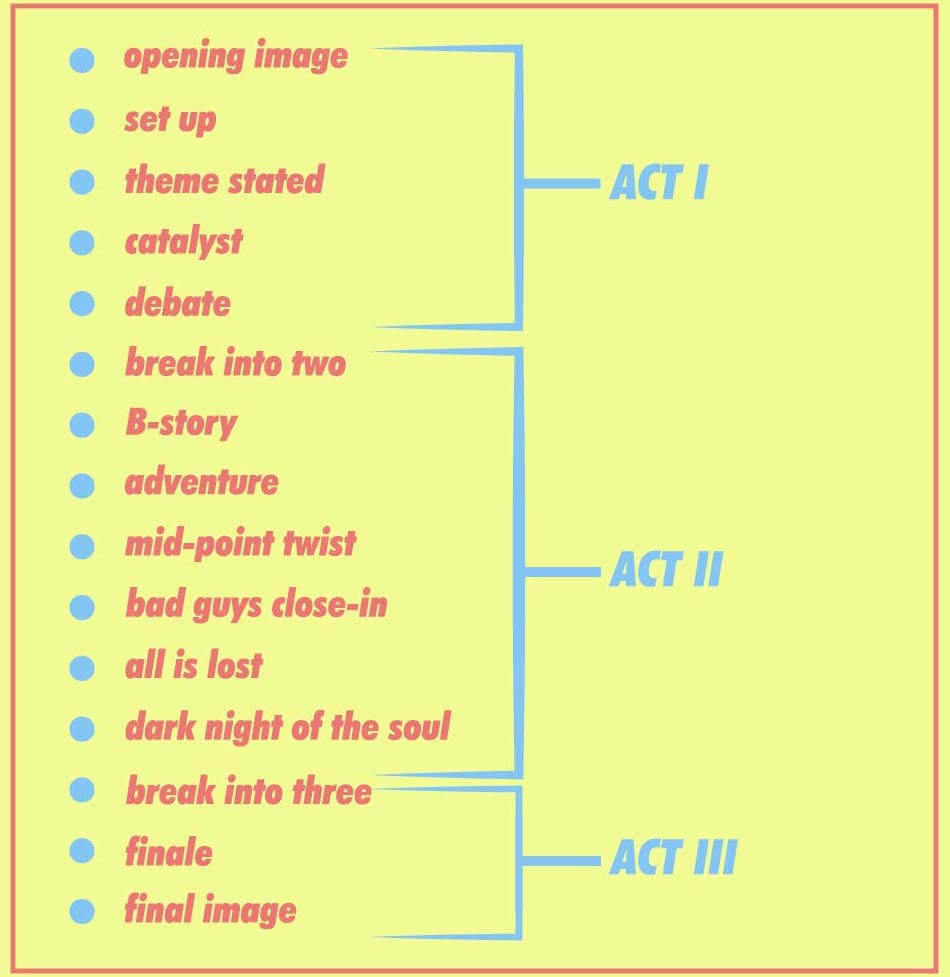Do you know what the average size of a novel is? 80,000 to 90,000 words. If you have a story concept, try stretching it out to make a 50,000-word novel. This is the problem most beginner writers face. Their entire plot finishes after page 30. How to add more substance to your story? How to make it much more detailed, deep, and enjoyable? You can follow the Save the Cat beat sheet by Blake Snyder
Save the Cat is a novel written by Blake Snyder and it’s about structuring a story. The beat sheet encapsulates the essence of the story, delivering the most informative part about story/scriptwriting. The whole process of writing a story is difficult, but when broken down into smaller bits, things start getting into the grasps of beginner writers.
This is what the Save the Cat beat sheet does. It divides the large process of story structuring into 15 smaller steps called “beats”. This article will present to you those beats and the reason why these components in your story matter. I have also added an example to elucidate the points better. Let’s begin.
The 15-Steps Beats Sheet
Before we dive into the “beats”, you must know some basics about the story structure. The entire plot of the story is divided into three parts called “acts”. These are acts one, two, and three.
Act one of the story is all about establishing the world, character, and the background of the story and it takes about 25% of the entire plot.
Act two is the largest part of the story, taking 50% of the entire plot. This is where the characters, storyline, relationships develop, and grow. A major portion of this part must be focused on the development of the story.
Act three is the finale of the story. This is where the climax begins and ends. The epic conclusion that every other event in the book has been leading up to is here. Again, this part takes 25% of the plot.

Opening image – A strong beginning to show what the story will feel like. I must capture the audience’s attention and get them excited. In a way, it should resemble the ending of the story (this will be discussed later). The opening of the story must elicit emotion from the readers, make sure that opening is engaging.
The Set up – This is the structural framework of your story. What is it about, how the world works, what the character does, how he thinks, and what kind of person he is. This is like establishing the background of the story. What the main character’s struggles are
Establish the world, the protagonist’s character, relation with the world, central problems, and the consequences in here to progress the plot.
Theme Stated – What your story wants to talk about. This is not the genre, this is what the essence of the story is. Is it a struggle? A self-revelation? Seeking freedom? Becoming better? Fighting evil? This theme is not known to the protagonist. The character shows their potential, but it isn’t complete or realized. The character needs to go through a difficult situation to bring it out.
Catalyst – Something that changes the life of the protagonist or the world around him. A catalyst must start something inside the main hero to leave the current life and go on a difficult journey to achieve something or to change the world. This is where a personal goal is given to the character. And it must be difficult.
Debate – The character must grow as the story goes and this is where he must doubt him or his abilities. You must show what shortcoming the character has and how reluctant he is to accept it. This is a personal challenge.
Break into two – This choice made by the protagonist now breaks the story into two parts, Act.1 and two. The two parts must work together while being slightly different. This choice must advance the plot, it could be taken with the end goal in mind but sometimes, changing that into something else also works great.
B story – B story is also called the sub-plot. It is generally the love story but you can use it to show anything that is connected with the theme. All you need to keep in mind is it must be slightly different from the main story but must work cohesively with the end goal. Stories can have many sub-plots, like a personal struggle of side characters, etc.
Hone your writing skills with these tips:
- How to create and implement narrative tension in your story?
- Using imagery in your story, according to Stephen King.
Adventure, learning, forming relations – After the character desires and struggles are explored and the B story starts, this is the major part of the book that will emotionally connected the readers with the story. If this fails, the story will not have any impact.
This is the fun part of the story where the characters learn new things, try and face challenges, develop relationships, care for each other, see the bigger picture. This is where the protagonist grows the most. And this is where you get to show your creativity
Create situations, world-building, great dialogues, scenes, etc. Give the readers an emotional roller coaster ride.
Go in-depth about other characters, reveal some more about the side characters, their backstories. This should be the largest section of the book as it is crucial for connecting the readers with the story and the characters.
Mid-point twist – This is where to bring the big twist and reorient everything. All that the character has learned previously is changed, and the pressure mounts up. All the fun and games were great, but now it is time to focus the attention of the readers on the main goal and the stakes are higher than ever. There could be betrayal, meeting a big failure, etc.
Bad guys close in – The second half of act 2. This is where the Bad guys will win and there is no way heroes have a shot. We get to see that the goal or bad guys are much more difficult, much more powerful than what was established before. Be clever here, try and make the situation as tricky as possible.
This is where everything they had seems to be not enough. The stress and tension is sky high, but the hope of revival lives
All is lost – The hope readers had is now all gone. And no one wants a sad ending. This makes the reader even more interested in finding out what will happen next. And this is your time to pull the strings of their hearts.
Everything the character had is gone, be it motivation or love or friends. He falls and gives up. The bad guys won and there is no way the hero is ever going to come back from it. Don’t let the readers get a way of seeing how things will become normal. Someone the protagonist loved is lost here
Dark Night of the soul – This is the personal defeat of the hero, the loss of hope, and the end of his/her journey. Everything he believed in, a change that was possible for him is now gone and he might criticize himself for taking the journey, there is no point in doing anything.
But a ray of hope shines. Using the sub-plots, there is something new that comes, something that changes his thoughts, his determinations. This is when the hero decides to relearn and change everything. A new beginning. This is the last hope he has and must choose again, but this time, his character change must reflect his choice.
Break into three – With this new hope, a new story begins that is in ties with the previous ones. But this time, things are serious and the hero has learned, prepared, and ready to go for it. His character change is evident and he is stronger now.
Finale – the five elements, also called the five-step finale is how writers add complexities to the climax of the story. While this is a brief mention, you can read a detailed article about the five-step finale here. The five elements of the good finale are;
Gathering the team – form the team that was once scattered. It could include lost friends, enemies that now want to take the protagonist’s side, etc.
Executing the plan – The team makes a plan and then attempt it. Everything seems to go well, all the things work out and the readers get excited. Finally, the hard work is paying off.
The high tower surprise – This is where you give the last and most impactful twist. The plan that was working out has failed, and it seems like the hero will lose.
Dig down deep – The hero now creates something genuinely unique, something unexpected that turns the situation in his/her favor. This is the reward you give the readers after being with your novel, for completing the story. Make sure this reward makes them feel happy.
Execution of the new plan – The unique plan that the hero brought from his thinking is now executed and the protagonists win. This marks the end of the climax.
Final image – Life after the end. It must be similar to the opening image, but the key difference is the character is a different, better person. He is happier and has people with him. Things have changed now. Now the theme of the story and the potential of the character (all of them) have been realized. A full circle.

Different ways of approaching this method?
For a new writer, it is essential to practice out this order of story structuring to understand the process, the flow of information, and the process of revelation. But is it the only way of telling the story? Certainly not. Adding your twist to it (literally) can make your story stand out.
Instead of approaching it this particular order, try changing how things happen. Maybe bring the ending first, then begin the story. Maybe show a false ending and then when the story ends, reveal that it was a false ending, shown in a way to mislead the readers.
Change the character’s motivation, change the way the antagonist is introduced. All these little changes and tweaks can enhance your story and make it stand out.
So go ahead and create the best story you can, now that you know the basics of structuring.







